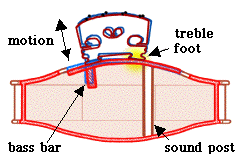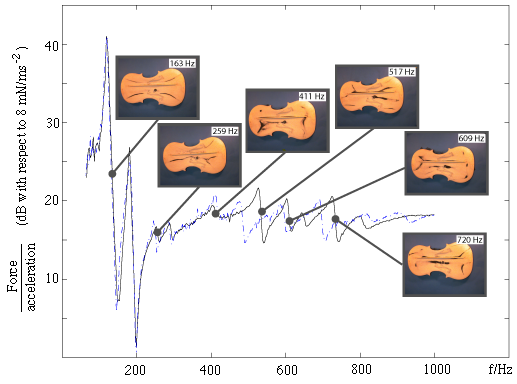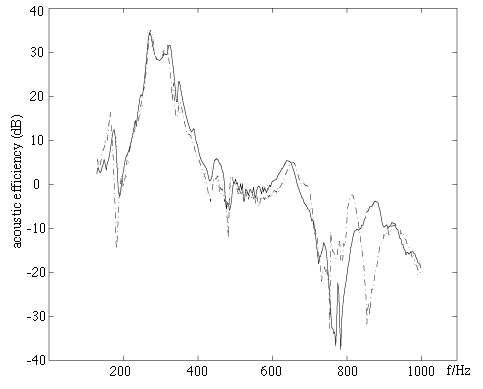First, something about sound.
 If you put your finger gently on a loudspeaker you will feel it
vibrate - if it is playing a low note loudly you can see it moving.
(More about loudspeakers.)
When it moves forwards, it compresses the air next to it, which
raises its pressure. Some of this air flows outwards, compressing
the next layer of air. The disturbance in the air spreads out as
a travelling sound wave. Ultimately this sound wave causes
a very tiny vibration in your eardrum.
If you put your finger gently on a loudspeaker you will feel it
vibrate - if it is playing a low note loudly you can see it moving.
(More about loudspeakers.)
When it moves forwards, it compresses the air next to it, which
raises its pressure. Some of this air flows outwards, compressing
the next layer of air. The disturbance in the air spreads out as
a travelling sound wave. Ultimately this sound wave causes
a very tiny vibration in your eardrum. |
At any point in the air near the source of sound, the molecules are moving
backwards and forwards, and the air pressure varies up and down by very
small amounts. The number of vibrations per second is called the frequency
which is measured in cycles per second or Hertz (Hz). The pitch of a note
is almost entirely determined by the frequency: high frequency for high
pitch and low for low. 440 vibrations per second (440 Hz) is heard as
the note A in the treble clef (the violin's A string), a vibration of
220 Hz is heard as the A one octave below, 110 Hz as the A one octave
below that and so on. We can hear sounds from about 15 Hz to 20 kHz (1
kHz = 1000 Hz). A double bass can play down to 41 Hz or below, and the
violin can play notes with fundamental frequencies well above 2 kHz. Human
ears are most sensitive to sounds between 1 and 4 kHz - about two to four
octaves above middle C.
(Here is a more technical introduction to sound and hearing.)
The violin: strings and bow, bridge and body
Strings
The pitch of a vibrating string depends on four things.
- Thicker, more massive strings vibrate more slowly so the strings
are thicker* as (on a violin) you go down from the E to A to D to G
strings, even though the length of the string doesn't change, and
its tension does not change much. (*Strictly, it's the mass per unit length, not the thickness.)
- The frequency can also be changed by changing the tension in the
string using the tuning pegs: tighter gives higher pitch. This is
what the player does when s/he tunes up.
- The frequency also depends on the length of the string that is free
to vibrate. The player changes this by holding the string firmly against
the fingerboard with the fingers of the left hand. Shortening the
string (stopping it further up the fingerboard) gives higher pitch.
- Finally there is the mode of vibration. When you play harmonics,
you induce the string to produce waves which are a whole fraction of the
length of those normally produced by a string of that length.
For more about strings and their motion, including harmonics, see Strings,
standing waves and haromonics. For their interaction with bows,
see the section Bows and strings.
The strings themselves make hardly any noise: they are thin and slip
easily through the air without making much of disturbance — and a sound
wave is a disturbance of the air. An electric violin or an electric
guitar played without an amplifier makes little noise. It is the bridge
and body of the acoustic violin that transmit some of the energy of vibration
of the strings into sound in the air.

This diagram showing the anatomy and nomenclature
of the violin is provided by Atelier
Labussiere.
The bridge
The bridge transfers some of the energy of vibration of the string
to the body of the violin. The bridge itself is very effective at
transmitting power to the body at frequencies from about one to
four kHz, which is where the ear is most sensitive. This is one
of the reasons for the bright timbre of the violin.You can reduce
the effectiveness of the bridge at transmitting power by attaching
a mass to it — the mass is usually called a mute, and it
serves to make the instrument both quieter and less bright in timbre.
The bridge stands on the belly between the f holes. These
holes have two different functions. One is to connect the air
inside to the air outside, and we talk about this below. The other
is a result of their length: the part of the belly lying between
the f holes can move more easily than can most of the wood of
the body. Let's see how this works.
The soundpost and bass bar
The treble foot of the bridge (the one under the E string) is quite
near the soundpost, which is a small post connecting the
relatively flexible belly plate of the violin to the much stiffer
back plate. This post helps prevent the belly from collapsing under the
vertical component of the tension in the strings, and it also couples
the vibrations of the plates. This connection to the stiffer back
plate restricts the motion of the treble foot considerably. The
bass foot of the bridge is much easier to move up and down. (Press
gently with your fingers and you can feel this difference.) As a
result, when a string is driven from side to side by the action
of the bow, the bridge tends to pivot about the treble foot, highlighted
in yellow in the sketch at right. The bass foot moves up and down
a little, moving part of the belly with it.
The position of the soundpost (which at low frequencies is the pivot for the motion of the
bridge) is critical to the sound of the instrument. Makers will
sometimes move it slightly to change the response of the instrument.
Small changes can have a noticeable effect and some violinists ask makers to adjust its position occasionally.
Under the belly on the bass foot side of the bridge is the bass
bar. It extends beyond the f-holes and thus transmits the
motion of the bass foot of the bridge over a large area of the belly. |

Cross section at the bridge, seen from the tailpiece
end. At low frequencies, the bridge oscillation approximates rotation around a point near the treble foot.
|

The body
The body: the front and back plates, the sides and the air inside: all serve to transmit the vibration of the bridge into vibration
of the air around the instrument. For this, the violin needs a relatively
large surface area so that it can push a reasonable amount of air
backwards and forwards. The most important part is the belly.
The belly or top plate. The belly and back plates are
made so that they can vibrate up and down relatively easily. The plates have
a number of resonances: i.e. there are certain frequencies at which
they vibrate most easily.
These are identified by luthiers and scientists using Chladni
patterns. To make the graph at right, isolated bellies were
driven mechanically at the position of the bass foot of the bridge,
and the acceleration was measured. The graph gives the ratio of
force to acceleration. If we were vibrating a small, localised mass, the
ratio would be that mass, independent of frequency. However, the belly flexes and does not accelerate homogeneously, which is why the
resonant behaviour of the plate appears here: the acceleration
produced by a given force is a strong function of frequency. On
this graph, each major resonance is indicated by an inset photograph
of its Chladni pattern.
The two curves here are for the bellies of two rather similar
violins.
When the violin is assembled, the resonances are more complicated.
However, the resonances are very important in transmitting the
varying force exerted at the foot of the bridge into radiated
sound.
|

The complete instrument
The graph at right shows the acoustic efficiency of two complete
violins. This is the ratio of the sound pressure produced (recorded
by a microphone near the f hole) to force applied (electromagnetically
at the bridge). The two curves are for the violins made from the
top plates whose properties are shown above. (The measurements were
made by Ra Inta, PhD student in Music Acoustics.)
The air inside and the Helmholtz resonance
The air inside the body is also important, especially for the low
range on the instrument. It can vibrate a little like the air in
a bottle when you blow across the top. In fact if you sing a note
near D4 close to the violin, and then hold your ear close to the
f-holes, you may hear the air in the body resonating. This is called
the Helmholtz
resonance. You can see the effect of this resonance at around
300 Hz in these two curves.
Resonances increase the sound output over some frequency ranges
Of both the violin and the guitar, we might say that the lowest
resonance (associated with the Helmholtz resonance) falls near the
pitch of the second lowest string, and the lowest body mode falls
near the pitch of the third lowest. Together these increase the sound
radiation at fundamentals of several of the notes in the low range
of the instrument. Further body resonances are distributed at higher
frequencies. These improve radiation of the fundamentals of higher
notes, and of harmonics of lower notes.
Where does the sound energy come from?
We have mentioned the importance of resonances in increasing the
sound output of the instrument. It is worth making it clear that
the body doesn't amplify the sound in the technical sense of the
word amplify. An electronic amplifier takes a signal with small
power and, using electrical power from the mains, turns it into
a more powerful signal. In the violin, all of the sound energy that
is produced by the body originally comes from energy put into the
string by the bow. The purpose of the body is to make that conversion
process more efficient. In an electric guitar, very little of the
energy of the plucked string is converted to sound. The body of
an acoustic guitar or violin is more efficient at converting some
of that energy into sound.
Timbre vibrato
An interesting characteristic feature
of the sound of members of the violin family is timbre vibrato,
which is largely due to the acoustic response of the body. We see
at right that the ratio of the sound pressure to the force that
the string exerts on the bridge is a very strong function of frequency,
because of the many resonances in the body. (This may seem strange
to someone with a background in hifi, where the aim is to produce
apparatus with negligible dependence on frequency!). When one plays
a note with a particular frequency, some but not all of the hamonics
coincide with resonances and so are strongly transmitted in the
output sound, while others are weaker.
Now consider what happens when the player rocks backwards and
forwards the finger that is stopping the string. This produces
a pitch vibrato: the pitch of note varies regularly up and down.
As it does so, the harmonics of the note also vary up and down
in frequency, and so they may move from a strong transmission
(due to a resonance) to weak transmission, or vice versa. This
means that the spectrum of the output note varies strongly during
the vibrato. Perceptually, this makes the sound much more interesting.
It is one of the two most important features that help us identify
the sound of a violin. (The other is the way in which a bowed
note begins.) We illustrate this with sound files here.
To get an idea of why vibrato is so important to the violin,
ask a violinist to play a long soft note on an open string, or
two notes simultaneously on two adjacent open strings. On the
open string, it will have no vibrato. Now close your eyes? Can
you imagine that it is an organ playing? Each time the bow changes
direction you can tell that it is a violin, but during sustained,
steady bowing it is much less clear. Now ask the violinist to
play the same single note, or a double-stopped fifth, on different
strings, and to play normally. How important is the difference?
We demonstrate this with soundfiles, waveforms and spectra on
the page Articulation
and vibrato on the violin.
See the paper on timbre vibrato by J. Meyer:
"On the Tonal Effect of String Vibrato", Acustica, 76 283-291
(1992) and Almeida, A., Schubert, E. and Wolfe, J. (2021) "Timbre Vibrato Perception and Description", Music Perception, 38, 282-292.
Bowing
The use of the bow is also very important to the violin sound. First,
it allows the production of a sustained note, whose loudness can
be held nearly constant or, at the performer's choice, varied over
time (musicans say 'shaping the note'). There is another important
difference between plucking and bowing. A plucked string very quickly
loses its high harmonics and, after a few seconds, nearly all of
the remaining energy in the string is in its fundamental. Bowing
inputs energy continuously to the string and thereby maintains the
power in the high harmonics. See Bows and
strings.
The bow can be used in a variety of different ways to produce
different articulations and sound effects. Some of these are demonstrated
with sound files, wave forms and spectra on Articulation
and vibrato on the violin.
|
For more information, see
|



